Content:
- Madang and Magadan
- Madang and Miklouho-Maclay
- Madang, Magadan and Magadha
- Manus
The city of Madang in Papua New Guinea is almost straight in the south from the Russian city of Magadan (the distance is 7 222 km.):
- Magadan (59°34’N 150°48’E)
- Madang (5°13’S, 145° 48’E)
These cities have one time zone, but due to internal reasons, Magadan has GMT +11, and Madang GMT +10.
II. Madang and Miklouho-Maclay
Madang has emerged quite recently, like most other settlements in Papua New Guinea. The first European to visit the territory of the 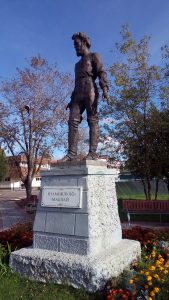 present Madang (the northern coast of Papua New Guinea) was famous Russian scientist and traveler Nicholas Miklouho-Maclay (1846 — 1888). He was born in region of the Valdai Hills which are rightly associated with the sacred mounts Meru and Hari. Moreover, his birthplace is only 30 km. from the lake
present Madang (the northern coast of Papua New Guinea) was famous Russian scientist and traveler Nicholas Miklouho-Maclay (1846 — 1888). He was born in region of the Valdai Hills which are rightly associated with the sacred mounts Meru and Hari. Moreover, his birthplace is only 30 km. from the lake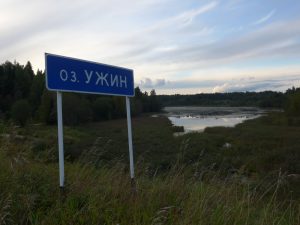 Ujin whose name is very close to the Ujjain, one of the sacred sites of the Buddhists and the Hindus.
Ujin whose name is very close to the Ujjain, one of the sacred sites of the Buddhists and the Hindus.
The Valdai Discussion Club was established in 2004 to promote dialogue of Russian and international intellectual elites and to deliver independent objective scholarly analysis of political, economic, and social developments in Russia and the world.
Miklouho-Maclay’s godfather was Nicholas Ridigier. This Russian German family has given Russian many famous people including Patriarch Alexy II (1929 — 2008), the primate of the Russian Orthodox Church. Close to Miklouho-Maclay’s birthplace was later borne Yuri Roerich, the most prominent 20th century Tibetologist. He was the son of the painter and explorer Nicholas Roerich and Helena Roerich who had contacts with the Mahatmas (the Great Teachers leading the human evolution).
In 1871, Miklouho-Maclay’s ship reached the north-eastern coast of New Guinea, entering the Astrolabe Bay. For several thousand 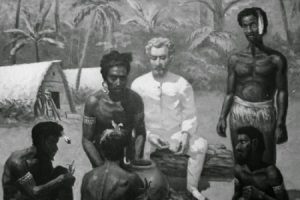 years before his arrival this land was inhabited only by primitive tribes. Miklouho-Maclay lived among the aborigines for 15 months. Then he lived there in 1876 — 1877 and in 1883. The Papuans called him the ‘Lunar Man’.
years before his arrival this land was inhabited only by primitive tribes. Miklouho-Maclay lived among the aborigines for 15 months. Then he lived there in 1876 — 1877 and in 1883. The Papuans called him the ‘Lunar Man’.
After Miklouho-Maclay is named the 300 km. long section of the above-mentioned coastline of Papua New Guinea. In 1875, Miklouho-Maclay offered the Russian government to establish a Russian colony here. In 1883 – 1884, he addressed a similar proposal to Emperor Alexander III and the Minister of Foreign Affairs. Miklouho-Maclay assumed a reserve option — the recognition of the independence of the territory. Acting norms of international law allowed Russia to do this and claim the rights to large plots of land bought by Russian citizen Miklouho-Maclay. The reason for the forced rejection of the appeal was doubt that Russia could retain this remote territory.
As a result, in December 1884, Germany announced the establishment of its protectorate over the northern part of New Guinea and the nearby islands. In 1886, on the site of today’s Madang formed a German settlement called Friedrich-Wilhelmshaven (see below).
III. Madang, Magadan and Magadha
There are no exact versions of the origin of the names Madang and Magadan. Usually, they search for a binding to the remaining local names. For example, the Magadanka River divides the city of Magadan into two parts, but where did this name come from, is still unknown. Magadan was founded in 1929, became a city in 1939. The region is known for rich mineral deposits (gold, polymetallic ores,  etc.). The golden deer in rapid leap personifies the two main branches of the economy of the Magadan region — gold
etc.). The golden deer in rapid leap personifies the two main branches of the economy of the Magadan region — gold 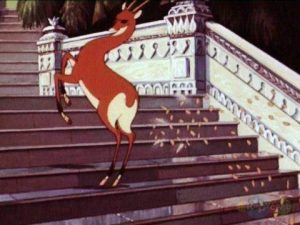 mining and reindeer breeding. There are certain parallels with the golden antelope from Indian fairy tales. It was able to strike the hooves from sparks to make gold. In 1954, the Soviet director Lev Atamanov created the cartoon drawing of the same name, which immediately became popular among children from different countries. The script was written on the motives of Indian tales by Nikolai Abramov.
mining and reindeer breeding. There are certain parallels with the golden antelope from Indian fairy tales. It was able to strike the hooves from sparks to make gold. In 1954, the Soviet director Lev Atamanov created the cartoon drawing of the same name, which immediately became popular among children from different countries. The script was written on the motives of Indian tales by Nikolai Abramov.
The city of Madang was founded in 1886 under the name of Friedrich-Wilhelmshaven by the German New Guinea company. This German colonial company exploited the northeastern part of New Guinea at the end of the 19th century. After the departure of the Germans, the city received the local name Madang. Today, Madang is considered one of the most developed cities in Papua New Guinea. Tourism, mining, and agriculture are developing. Madang belongs to the most picturesque places of the South Pacific.
Madang and Sandaun are two of the four provinces of the region of Momase. The administrative center of the province of Sandaun is the city of Vanimo. Vanino is a Russian seaport of federal significance on the coast of the Pacific Ocean.
Sandaun literally means ‘sunset’, because this province is located to the west of most of the remaining provinces of Papua New 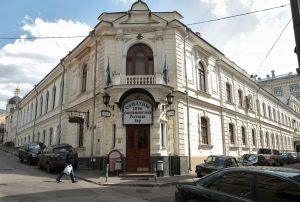 Guinea. In Moscow, the most famous historical baths are the Sanduny, which have been in operation from XIX century to the present. The founder and the first owner of this bath was Sila Sandunov and his wife Elizaveta Uranova. Both were well-known actors of the court theater of Empress Catherine the Great (1729 – 1796), the country’s longest-ruling female leader. She was born Pomerania, Prussia (now Szczecin, Poland). Also, Poland is one of four villages on the Christmas Island (Republic Kiribati), see below.
Guinea. In Moscow, the most famous historical baths are the Sanduny, which have been in operation from XIX century to the present. The founder and the first owner of this bath was Sila Sandunov and his wife Elizaveta Uranova. Both were well-known actors of the court theater of Empress Catherine the Great (1729 – 1796), the country’s longest-ruling female leader. She was born Pomerania, Prussia (now Szczecin, Poland). Also, Poland is one of four villages on the Christmas Island (Republic Kiribati), see below.
On the occasion of their wedding, the Empress presented diamonds to which they were able to buy the land and arrange a bath in the center of Moscow. The wedding of Sandunov and Uranova took place in the palace church, in 1791, on February 14 (modern Valentine’s Day). The Empress herself dressed the bride.
 Sandunov came from the noble Georgian family Zandukeli, whose representatives moved to Russia in the 18th century, together with King Vakhtang VI, who occupies a special place among the cultural figures of Georgia (the Caucasus). Being a well-educated person, he did a lot for the cultural uplift of his country. Vakhtang VI is buried in the Assumption Cathedral of the Astrakhan Kremlin (Southern Russia, the Caspian Sea). In Sanskrit, ‘astra’ means ‘heaven’, ‘weapon’. Not far from the Astrakhan Kremlin, on Volodarsky Street 14, is the building of the former Indian trading house. It is symbolic that just above the commemorative plaque, ‘Razum!’ (‘mind’ in English) is written on the wall. In Sanskrit (the language of Indian holy books), ‘mind’ is ‘manas’. See below Manus.
Sandunov came from the noble Georgian family Zandukeli, whose representatives moved to Russia in the 18th century, together with King Vakhtang VI, who occupies a special place among the cultural figures of Georgia (the Caucasus). Being a well-educated person, he did a lot for the cultural uplift of his country. Vakhtang VI is buried in the Assumption Cathedral of the Astrakhan Kremlin (Southern Russia, the Caspian Sea). In Sanskrit, ‘astra’ means ‘heaven’, ‘weapon’. Not far from the Astrakhan Kremlin, on Volodarsky Street 14, is the building of the former Indian trading house. It is symbolic that just above the commemorative plaque, ‘Razum!’ (‘mind’ in English) is written on the wall. In Sanskrit (the language of Indian holy books), ‘mind’ is ‘manas’. See below Manus.
Razumovsky or Razum, i.e. ‘mind’, was the surname of the secret spouse of Russian Empress Elizabeth (1709 – 1762) who chose the aforementioned future Catherine the Great as the wife of her nephew Peter III, who was the grandson of Russian Peter I (on the female line) and Swedish Charles XII (on the male line), who battled each other furiously. The Volodarsky Street on which stands the former Indian trading house was formerly called the Indian Street.
Magadha is a historical region and an ancient kingdom in the east of India. It arose in the time of the Buddha and lasted for a thousand years until the 6th century BC. Magadha was the largest economic, cultural, educational and religious center. Magadha is considered to be the historical nucleus of modern Indian civilization. Geographically, this is the current neighboring states of Bihar (where Buddha lived and preached) and Jharkhand (40% of India’s mineral reserves are concentrated there). They border on the state of Orissa (Odisha), where the first emperor of India and one of the greatest rulers in the history of mankind, Ashoka converted to Buddhism.
In Sanskrit, the word ‘magadha’ means ‘minstrel’, ‘poet’, ‘singer’, ‘composer of ballads’. It denotes ‘the country of the Magadhs’.
Certain linguistic (semantic) parallels exist in the names Madang, Magadan, Magadha with Agade — the capital of Nibiru, as well as with the Mesopotamian Agade — the first empire built by Ishtar (Inanna) and her earthly husband with Nibiruan farther Sargon of Akkad (also known as Sargon the Great). Nibiruans had the direct relation to the New Year celebration in Mesopotamia. It was the most important event and was dedicated to the arrival of the Nibiruans to Earth.
Today, the first place on the planet celebrating the New Year is Caroline Island or Caroline Atoll (also known as Millennium Island) in the Republic of Kiribati, the equatorial state in the central part of the Pacific Ocean.
Initially, Kiribati was called the Gilbert Islands. Kiribati is the local pronunciation of the English word Gilberts, the surname of the English captain, in honor of whom these islands were named by Ivan Krusenstern, the famous Russian navigator and the commander of the first Russian round-the-world expedition. This famous journey was organized by the Russian-American Company, which had a direct relationship to Great Ustyug, and was interested in sea communication with the Russian America (Alaska) it managed. The land route from the St. Petersburg to Russian America and back took 5 years. The sea route took significantly less time.
Under the coat of arms of the Republic of Kiribati is its national motto: «Health, peace and prosperity«. The emblem depicts a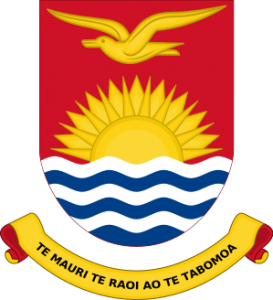 yellow frigate flying over the rising Sun. Frigates are related to pelicans and cormorants. Seagull in the rays of the rising Sun was a favorite plot of Russian sailors and fishermen. The seagull transmits the height of the spirit and the power of the flight of the soul. The rising Sun symbolizes freedom.
yellow frigate flying over the rising Sun. Frigates are related to pelicans and cormorants. Seagull in the rays of the rising Sun was a favorite plot of Russian sailors and fishermen. The seagull transmits the height of the spirit and the power of the flight of the soul. The rising Sun symbolizes freedom.
Following Kiribati, New Zealand and polar explorers from the South Pole in Antarctica greet the New Year. In the 19th century Antarctica was opened to the world by Russian navigators led by the Captain Bellingshausen, the student of Kruzenstern.
It is noteworthy that in the Russian the name of Kiribati begins with the name of Kir (Cyrus the Great), the founder of Achaemenid Empire, the first Persian Empire. In fact, it is related to the surname of the first European (Portuguese navigator Pedro Kiros) to see the atoll Caroline and discover the Christmas Island. This Christmas Island is the largest atoll in the world in terms of land area. As mentioned above, Caroline atoll is the first to celebrate the New Year.
In order the Caroline atoll became the first firm land (outside Antarctica), which will first meet the sunrise on January 1, 2000, the Kiribati authorities went to a certain, but commercially reasonable trick. In the symbolic period of the winter solstice (the struggle of light and darkness), on December 23, 1994, the Kiribati government announced a change of the time zone on their territory. The time zone change made Caroline atoll the easternmost point of the twelfth time zone, which first meets the new day. In 1999, to attract international attention and the media, the Caroline atoll was officially renamed the Millennium Island. It was the first land (outside Antarctica) to meet the sunrise on January 1, 2000, during the change of epochs (Pisces → Aquarius).
About one billion viewers from different countries watched on television this event on the island. However, de facto, the first place on the planet that met the dawn of the New Year (era) was not the Millennium Island (the Caroline atoll), but a small piece of land in the east of Antarctica, where the Millennium came 35 minutes earlier. This place is on the same latitude as the Russian Antarctic station Mirny named after the Russian ship discovered the continent of Antarctica and twice circumnavigated it.
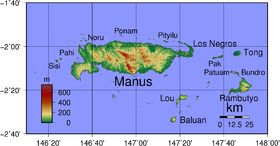 Manus Island (and the same-named province of Papua New Guinea) is located at 350 km. to the north-east of the above-mentioned town of Madang, where Miklouho-Maclay landed and lived among the Papuans. The province’s airport is on the small but second largest island of Los Negros.
Manus Island (and the same-named province of Papua New Guinea) is located at 350 km. to the north-east of the above-mentioned town of Madang, where Miklouho-Maclay landed and lived among the Papuans. The province’s airport is on the small but second largest island of Los Negros.
On the island of Los Negros is the Kingdom of Manna, whose tasks can be characterized by the national motto of the above-mentioned Republic of Kiribati («Health, Peace and Prosperity»), but only for all beings on the planet, and not for a single state or community. It is no accident that the abbreviation of the kingdom (KOM) can be seen in the word communism (from the Latin word ‘common’). In the highest sense, these are the ideas of a spiritually developed society based on the understanding of universal Unity in the Creator. In the center of the emblem of the Sovereign Kingdom of Manna is placed the Flower of Life, one of the oldest images that can be found in the sacred places of the planet. It is believed that this universal symbol contains all the secrets of the Universe.
In Sanskrit, ‘manas’ means ‘mind’. The word ‘manasa’ is translated as ‘spiritual’, ‘mental’. In Indian philosophy, the term ‘manas’ has a profound meaning. It is manas that makes man a rational and moral being. In Russia there are rivers with the name of Mana (Siberia) and Main (Ulyanovsk region that is the birthplace of Lenin, the founder of the Soviet Union).
The largest island in the province is Manus. Los Negros and Manus are members of the Admiralty Islands, a group of 40 islands in the Bismarck Archipelago. The largest island of the Bismarck Archipelago is New Britain, formerly known as New Pomerania. Catherine of Russia was born in Pomerania (Prussia), see above.
Manam Island is located 150 km. north-west of the city of Madang and about 30 km. from the mouth of the Ramu River, flowing through the province of Madang and carrying its waters to the Sea of Bismarck. Ramu has a large number of tributaries originating in the mountains of Bismarck. Rama is the protagonist of the Ramayana, the second most important sacred text of the Hindus. The first is the Mahabharata. Described in it the great battle on the Kuru field could have a direct connection to the Battle of Kursk between the German and Russian forces, one of the greatest battles of the Second World War. It was Bismarck who perspicaciously persuaded descendants to never fight with Russia.
Bismarck and Russia
This German politician of the 19th century transformed Prussia into a dominant force in Germany and, ultimately, united the German princedoms into a single national state.
From 1859 to 1862 Bismarck served as Ambassador of Prussia to Russia. Living in Saint-Petersburg, he learned Russian well and understood the essence of the Russian way of thinking. Bismarck knew and understood the Russians well. It was very helpful to him in choosing the right political line with regard to Russia. Bismarck did the most accurate and correct statements about the Russians and Russia.
Bismarck was supported by the Russian diplomacy helping him create the united Germany in order to have a counterweight to England and France. The mentor and friend of Bismarck was the Russian chancellor Gorchakov, the head of the Russian foreign policy department under Alexander II. Gorchakov knew all the behind-the-scenes movements of international politics in Europe. He was born on the shore of the Baltic Sea, 90 km. from Tallinn, where the above mentioned Krusenstern is buried and 80 km away from Parnu, the city which is connected to the coat of arms of the Romanovs.
Bismarck was a descendant of the Rurik, his distant kin was the French Queen Anna who was the daughter of Yaroslav the Wise (one of the greatest Russian rulers). The mature Bismarck, then the envoy of the Prussian king in Paris, had a young Russian love. 47-year-old Bismarck persistently courted the 22-year-old princess Ekaterina Orlova (Trubetskaya), the wife of the Russian ambassador in Paris, Nikolai Orlov, whose grandfather was Fedor Orlov, one of the famous Orlov brothers who helped the future Catherine the Great to become Russian empress.
Ekaterina Orlova came from one of the oldest aristocratic clans of Russia. They originally owned the Trubetskoe principality. The 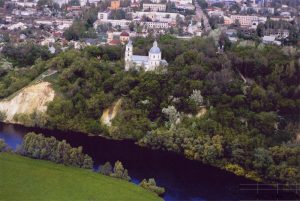 center of this specific Russian principality was the city of Trubchevsk, founded in the year 975. Trubchevsk (present-day Bryansk region) stands on the river with the Sanskrit name Desna (the longest tributary of the Dnieper). Desna and the Dnieper originate in the Smolensk region, like the Ugra River — one of the epithets of Indian god Shiva. In Sanskrit, ‘ugra’ means ‘formidable’, and ‘desna’ means ‘gift’. Two rivers with the name Desna are near Moscow.
center of this specific Russian principality was the city of Trubchevsk, founded in the year 975. Trubchevsk (present-day Bryansk region) stands on the river with the Sanskrit name Desna (the longest tributary of the Dnieper). Desna and the Dnieper originate in the Smolensk region, like the Ugra River — one of the epithets of Indian god Shiva. In Sanskrit, ‘ugra’ means ‘formidable’, and ‘desna’ means ‘gift’. Two rivers with the name Desna are near Moscow.
The son of Ekaterina Orlova prince Vladimir Orlov for a long time was a confidant of the last Tsar Nicholas II.
